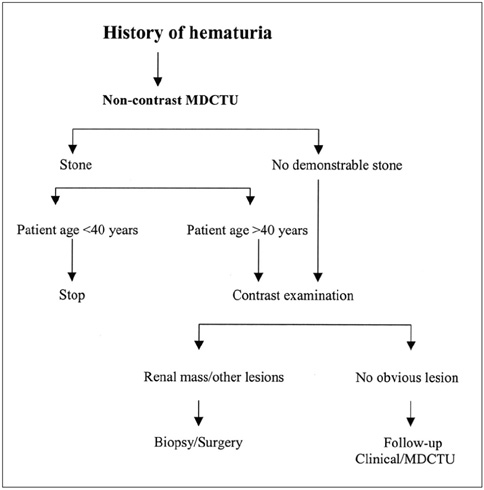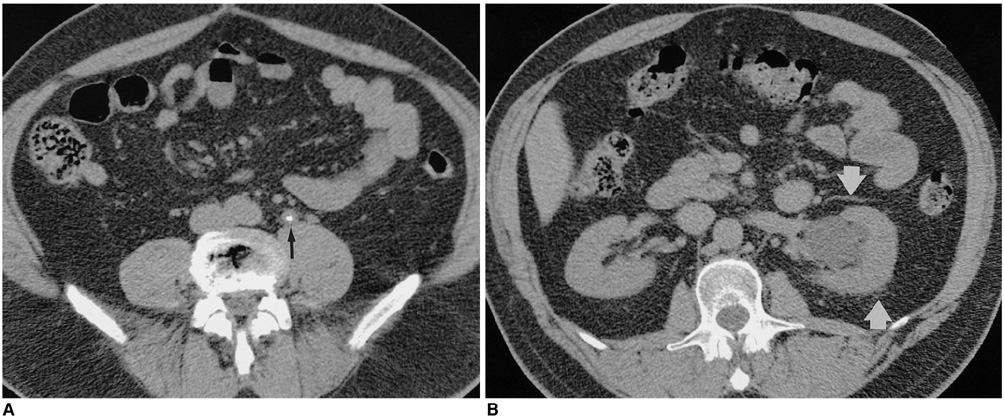Korean J Radiol.
2004 Mar;5(1):1-10. 10.3348/kjr.2004.5.1.1.
Multidetector CT Urography in Imaging of the Urinary Tract in Patients with Hematuria
- Affiliations
-
- 1Department of Radiology, Massachusetts General Hospital, Harvard Medical School. ssaini@partners.org
- KMID: 1066239
- DOI: http://doi.org/10.3348/kjr.2004.5.1.1
Abstract
- This review article comprehensively discusses multidetector CT urography protocols and their role in imaging of the urinary tract in patients with hematuria.
Keyword
MeSH Terms
Figure
Reference
-
1. Chow LC, Sommer FG. Multidetector CT urography with abdominal compression and three-dimensional reconstruction. AJR Am J Roentgenol. 2001. 177:849–855.2. Kim JK, Ahn JH, Park T, Ahn HJ, Kim KS, Cho KS. Virtual cystoscopy of the contrast-filled bladder in patients with gross hematuria. AJR Am J Roentgenol. 2002. 179:763–768.3. Pollack HM. Gagliardi RA, McClennan BL, editors. Uroradiology. A history of the radiological science. 1996. Reston, Virginia: American Roentgen Ray Society;237–238.4. Amis ES. Epitaph for the urogram. Radiology. 1999. 213:639–640.5. Fielding JR, Silver SG, Rubin GD. Helical CT of the urinary tract. AJR Am J Roentgenol. 1999. 172:1199–1206.6. Urban BA. The small mass: What is the role of multiphasic helical scanning? Radiology. 1997. 202:22–23.7. Chai RY, Jhaveri K, Saini S, Hahn PF, Nichols S, Mueller PR. Comprehensive evaluation of patients with hematuria on a multislice computed tomography scanner: Protocol designs and preliminary observations. Australas Radiol. 2001. 45:536–539.8. Grossfield GD, Litwin MS, Wolf JS, et al. Evaluation of asymptomatic microscopic hematuria in adults. The American Urological Association Best Practice Policy-Part 1: definition, detection prevalence and etiology. Urology. 2001. 57:599–603.9. Jones DL, Langstaff RJ, Holy SD, et al. The value of cystoureteroscopy in the investigation of microscopic hematuria: a prospective study of 100 patients. Br J Urol. 1988. 62:541–545.10. Grossfield GD, Litwin MS, Wolf JS, et al. Evaluation of asymptomatic microscopic hematuria in adults. The American Urological Association Best Practice Policy-Part II: Patient evaluation, cytology, voided markers, imaging, cystsocopy, nephrology, evaluation and follow-up. Urology. 2001. 57:604–610.11. Maher MM, Jhaveri K, Lucey BC, et al. Does the administration of saline flush during CT urography (CTU) improve ureteric distension and opacification? Radiology. 2000. 221(p):500.12. McTavish JD, Jinaki M, Zou KH, Silverman SG. Multidetector CT urography: analysis of techniques and comparison with IVU. Radiology. 2000. 27(p):225.13. Caoili EM, Cohan RH, Korobkin M, et al. Urinary Tract Abnormalities: Initial Experience with Multi-Detector Row CT Urography. Radiology. 2002. 222:353–360.14. Heneghan JP, Kim DH, Leder RA, DeLong D, Nelson RC. Compression CT urography: a comparison with IVU in the opacification of the collecting system and ureters. J Comput Assist Tomogr. 2001. 25:343–347.15. Birnbaum BA, Jacobs JE, Ramchandani P. Multiphasic renal CT: comparison of renal mass enhancement during the corticomedullary and nephrographic phases. Radiology. 1996. 200:753–758.16. Sussman SK, Illescas FF, Opalacz JP, et al. Renal streak artifact during contrast enhanced CT. comparison of high versus low osmolality contrast media. Abdom Imaging. 1993. 18:180–185.17. Maher MM, Prassad TA, Fitzpatrick JM, et al. Spinal dysraphism at MR Urography: Initial experience. Radiology. 2000. 216:237–241.18. Kim JK, Cho KS. CT urography and virtual endoscopy: promising imaging modalities for urinary tract evaluation. Br J Radiol. 2003. 76:199–209.19. Levine JA, Neitlich J, Verga M, et al. Ureteral calculi in patients with flank pain: correlation of plain radiography with unenhanced helical CT. Radiology. 1997. 204:27–31.20. Fielding JR, Fox LA, Heller H, et al. Spiral CT in the evaluation of flank pain: overall accuracy and feature analysis. J Comput Assist Tomogr. 1997. 21:635–658.21. Dalla Palma L. What is left of IV urography? Eur Radiol. 2001. 11:931–939.22. Kawashima A, Sandler CM, Boridy IC, et al. Unenhanced helical CT of ureterolithiasis: value of the tissue rim sign. AJR Am J Roentgenol. 1997. 168:997–1000.23. Bell TV, Fenlon HM, Davison BD, et al. Unenhanced helical CT criteria to differentiate distal ureteral calculi from pelvic phleboliths. Radiology. 1998. 207:363–367.24. Boridy IC, Nikolaidis P, Kawashima A, et al. Ureterolithiasis: value of the tail sign in differentiating phleboliths from ureteral calculi at nonenhanced helical CT. Radiology. 1999. 211:619–621.25. Coll DM, Varanelli MJ, Smith RC. Relationship of spontaneous passage of ureteral calculi to stone size and location as revealed by unenhanced helical CT. AJR Am J Roentgenol. 2002. 178:101–103.26. Jamis-Dow CA, Choyke PL, Jennings SB, et al. Small (<3 cm) renal masses: detection with CT versus US and pathologic correlation. Radiology. 1996. 198:785–788.27. Polascik TJ, Pound CR, Meng MV, et al. Partial nephrectomy: technique, complications and pathological findings. J Urol. 1995. 154:1312–1318.28. Polascik TJ, Meng MV, Epstein JI, et al. Intraoperative sonography for the evaluation and management of renal tumors: experience with 100 patients. J Urol. 1995. 154:1676–1680.29. Bosniak MA. The current radiological approach to renal cysts. Radiology. 1986. 158:1–10.30. Abdulla C, Kalra MK, Saini S, et al. Pseudoenhancement of "renal cysts" by different multidetector CT scanners: a phantom experiment. AJR Am J Roentgenol. 2002. 179:1473–1476.31. Bosniak MA, Rofsky NM. Problems in the detection and characterization of small renal masses. Radiology. 1996. 198:638–641.32. Liu W, Esler SJ, Kenny BJ, et al. Low-dose nonenhanced helical CT of renal colic: assessment of ureteric stone detection and measurement of effective dose equivalent. Radiology. 2000. 215:51–55.33. Atasoy C, Yagci C, Fitoz S, et al. Cross-sectional imaging in ureter tumors: findings and staging. Clin Imaging. 2001. 25:197–202.34. Song JH, Francis IR, Platt JF, et al. Bladder tumor extension at virtual cystoscopy. Radiology. 2001. 218:95–100.35. Kwashima A, LeRoy AJ. Radiologic evaluation of patients with renal infections. Infect Dis Clin North Am. 2003. 17:433–456.36. Kawashima A, Sandler CM, Goldman SM, et al. CT of renal inflammatory disease. RadioGraphics. 1997. 17:851–866.37. Kawashima A, Sandler CM, Goldman SM. Current roles and controversies in the imaging evaluation of acute renal infection. World J Urol. 1998. 16:9–17.38. Kawashima A, Fishman EK, Goldman SM, et al. Helical CT of acute pyelonephritis: is there an ideal timing for imaging? Radiology. 1996. 201:148–149.39. Hoddick W, Jeffrey RB, Goldberg HI, et al. CT and sonography of severe renal and perirenal infections. AJR Am J Roentgenol. 1983. 140:517–520.40. Lang EK, Macchia RJ, Thomas R, et al. Detection of medullary and papillary necrosis at an early stage multiphase helical computerized tomography. J Urol. 2003. 170:94–98.
- Full Text Links
- Actions
-
Cited
- CITED
-
- Close
- Share
- Similar articles
-
- Upper Urinary Tract Gross Hematuria: Clinical Diagnosis and Disease Distribution
- Comparison of CT Urography and Intravenous Urography in Patients with Hematuria
- Drug-induced MR Urography: The effects of Furosemide and Intravenous Saline Injection on MR Urography of Obstructed and Non-obstructed Urinary Tract
- A Clinical Observation on Urothelial Tumor of the Upper Urinary Tract
- Clinical Usefulness of Multi-Detector Computed Tomography in Diagnosis of Patients with Microscopic Hematuria










